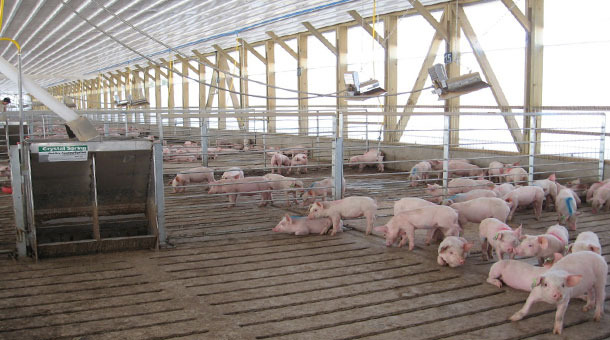Digestive health in piglets is very important to ensure optimum feed conversion efficiency. Little work has been done so far in prevention and control of digestive health compared to respiratory pig health. This article suggests a system to evaluate intestinal health in the pig population.
Currently, there is a very practical tool to analyze intestinal health in a group of piglets, the lactobacillus:coliforms ratio. Before weaning, the amount of lactobacillus or lactic acid bacteria in the piglet is higher, while the amount of coliforms is lower. After weaning this ratio is reversed (see Figure 1), and depending on coliform growth and/or immune development of the animal, a digestive infection might develop (Jensen, 1998; Pieper et al., 2006). Piglet intestinal flora is made up of bacteria (lactobacillus, bifidobacteria, proteus, etc.) and yeasts. These organisms help digest nutrients, protect the mucous membranes and fight against other pathogenic bacteria known as enterobacteria and/or coliforms. The greater the amount of beneficial intestinal flora the piglet has, the less chance the piglet will develop diarrhoea, since lactobacillus concentration is directly proportional to good intestinal health. The lactobacillus:coliform ratio is an index of scientific interest. It is used experimentally in efficacy tests of feed additives and acidifiers looking to promote immune defence.


Average number of bacteria contained in piglets caeca at different stages after weaning
Figure 1. Average number of bacteria contained in piglets colon at different stages after weaning
(Adapted from Pieper et al., 2006)
How do we obtain the lactobacillus: coliform ratio of a pig population?
In field conditions it is essential to carry out an analysis of a group of piglets to determine the intestinal health status of the farm, but how do we obtain the samples? What kind of analysis do we request from the lab? How many samples do I send to the lab?
The collection of representative samples of the pig population is a priority. For example, in a farm of 1000 breeding sows, the weekly flow of piglets will amount to about 500 animals, of which at least 19 should be sampled. This sampling will allow us to detect, in a population of 500 individuals, the presence of at least one infected individual, with a confidence level of 95% and assuming an expected minimum prevalence of 15% of diarrhoea cases.
The sample to be obtained is 100 grams of faeces from a 1 to 2 weeks post-weaning.piglet, The sample should be placed in a sterile bag, kept refrigerated and analysed within 6 hours in the laboratory. The type of analysis should be a CFU (colony forming units) count for coliforms and lactobacillus. Specific agar media must be used for each type of bacteria.

Nursery
How to interpret the results
Our main objective is to achieve a lactobacillus:coliforms ratio of 1.3 or greater, where the amount of lactobacillus in caecum obtained from the rectum is bigger than 9 log cfu/g, and coliforms smaller than 7 log cfu/g. If an index below 1.3 is obtained, it may be indicative of diarrhoea in piglets.
When analysing a population, it is very important to know that when the lactobacillus:coliform ratio of 15% or more of the samples is lower than 1.3, the population is at high risk of developing diarrhoea and preventive measures must be taken as a priority. When the prevalence of animals scoring less than 1.3 points is 5% or lower, chances of an enteric problem in the population are minimal.

How often should I do this test?
The frequency of analyses should be every 3 months during one production week chosen at random. Although it should also be done when additives are added to the feed formulation in order to enhance piglet intestinal health.
Conclusion
A piglet population with good intestinal health will have an excellent feed conversion efficiency, as those piglets will have smaller challenges that interfere in the quality of intestinal villi, crypts depth and intestinal flora.
To ensure optimum feed conversion, it is essential that the pig has the minimum possible exposure to pathogenic bacteria during its productive life, both respiratory and digestive. Hence the importance of maintaining piglet intestinal flora in optimum conditions and avoiding inappropriate use of antibiotics, since many of them generate dysbiosis and imbalance of saprophytic flora affecting performance and subsequent growth of the piglet. "Management of piglet intestinal flora starts at gestation, as a sow with optimal intestinal flora will colonize her piglets, to a large extent, with her intestinal flora."
When we understand that analyzing the intestinal situation of our piglets is an essential part of health management programs, we will give feed efficiency strategies a big push. These challenges are and will become even more important in the coming years.


